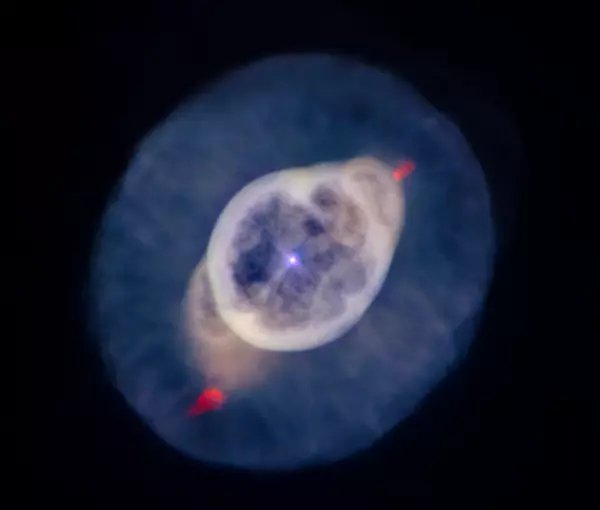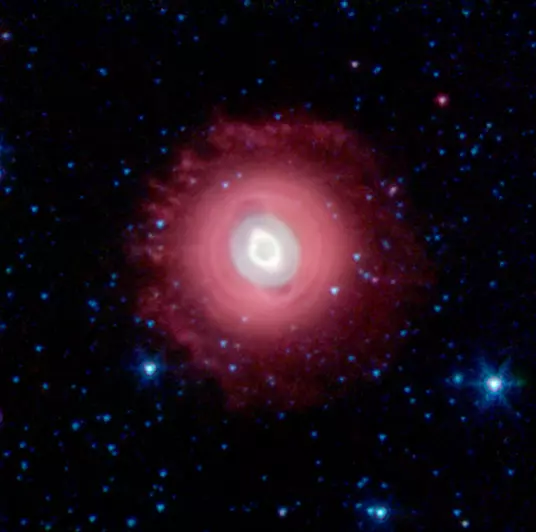The Ghost of Jupiter (NGC 3242) is a planetary nebula located approximately 4,800 light years away in the constellation Hydra. With an apparent magnitude of 8.60 and an apparent size of 25 arcseconds, it can be observed in amateur telescopes. The nebula is catalogued as Caldwell 59 in the Caldwell catalogue. It is one of the most popular telescope targets not listed in the Messier catalogue.
The nebula was nicknamed the Ghost of Jupiter or Jupiter’s Ghost because it has a similar apparent size to Jupiter. The resemblance was first noted by the 19th century British astronomer William Henry Smyth.
Despite its nickname, Jupiter’s Ghost Nebula does not have anything to do with Jupiter. It simply bears a passing resemblance to the planet in a small telescope, much like the Saturn Nebula (NGC 7009) looks a bit like Saturn. The resemblance of these objects – or at least their central regions – to planets is what led to the creation of the term “planetary nebula.” The origin of the term is uncertain, but William Herschel used it in the 18th century and listed 78 “planetary nebulae” in his catalogue. Most of them were later discovered to be galaxies.

After an average star like the Sun finishes burning through the supply of hydrogen and helium fuel in its core, it swells up into a cool, red giant star. In a last gasp before its end, it throws off the layers of gas in its outer atmosphere in a brief but beautiful cosmic display called a planetary nebula. This exposes the core of the star — a dense, hot ball of carbon and oxygen called a white dwarf, which is doomed to fade out completely over time. The white dwarf is so hot that it shines very brightly in ultraviolet light, which then causes the gaseous material expelled by the star to glow. Hubble’s Wide Field and Planetary Camera 2 captured this image of Caldwell 59, a planetary nebula also cataloged as NGC 3242. The ghostly image is part of a collection of Hubble observations made of planetary nebulas in the mid-1990s, which revealed never-before-seen details in these stellar shrouds and helped astronomers better understand the late evolutionary stages of average, mid-size stars. Image: NASA, ESA, Bruce Balick and Jason Alexander (University of Washington), Arsen Hajian (U.S. Naval Observatory), Yervant Terzian (Cornell University), Mario Perinotto (University of Florence), Patrizio Patriarchi (Arcetri Observatory) and Reginald Dufour (Rice University); Processing by Gladys Kober (NASA/Catholic University of America) (CC BY 2.0)
NGC 3242 is sometimes also known as the Eye Nebula. It spans about 2 light years across. The central white dwarf, designated HD 90255, has an apparent magnitude of 11.
Like all planetary nebulae, NGC 3242 was formed when a low to intermediate-mass star reached the end of its life and expelled its outer layers, leaving behind the remnant core, a hot white dwarf. The ultraviolet light from the central star ionizes the expelled gas, causing the nebula to glow.

Jupiter’s Ghost by NASA’s Spitzer Space Telescope, image: NASA/JPL-Caltech/Harvard-Smithsonian CfA
Planetary nebulae are relatively short-lived objects, lasting only a few tens of thousands of years before the central white dwarfs and the surrounding gaseous material cool. The concentric rings around the central star are formed of material periodically expelled in the final stages of the star’s life cycle. The extended region of nebulosity may either be material ejected from the star when it was a red giant, or an unrelated cloud of interstellar gas illuminated by the nebula’s central star.
The inner layers of the Ghost of Jupiter Nebula formed about 1,500 years ago. The ends along the symmetry axis are marked by Fast Low-Ionization Emission Regions (FLIERs). These are lobes of gas moving at supersonic speeds, much faster than the outflow speed of the rest of the nebula. The high speeds of these regions indicate an age significantly younger than the nebula itself. The low ionization suggests that the ultraviolet radiation that makes the nebula glow does not get through into the FLIERs. The Blinking Planetary Nebula (NGC 6826) in the constellation Cygnus is another well-known example of a planetary nebula with FLIERs at the poles. Many planetary nebulae have this feature.

Ghost of Jupiter (Caldwell 59), image: Judy Schmidt (CC BY 2.0)
A 2021 study of central stars in 2,035 planetary nebulae used data from the Gaia Early Data Release 3 (EDR3) and identified the central star in Jupiter’s Ghost as an O-type star with the stellar classification O(H).
Facts
NGC 3242 was discovered by the German-born British astronomer William Herschel on February 7, 1785. He listed it as H IV.27 in his catalogue. His son John Herschel observed the nebula from the Cape of Good Hope in South Africa in the 1830s and catalogued it as h 3248. He later listed it as GC 2102 in the 1864 General Catalogue.
When Danish astronomer John Louis Emil Dreyer compiled the New General Catalogue of Nebulae and Clusters of Stars in 1888 based on William Herschel’s 1786 Catalogue of Nebulae and Clusters of Stars (CN) and the supplementary Index Catalogues, he included the Ghost of Jupiter as NGC 3242. The NGC designation is still commonly used today.

This ultraviolet image from NASA’s Galaxy Evolution Explorer shows NGC 3242, a planetary nebula frequently referred to as “Jupiter’s Ghost.” The unfortunate name of “planetary nebula” for this class of celestial object is a historical legacy credited to William Herschel during the 18th century — a time when telescopes where small and objects like these, at least the central region, looked very similar to gas-giant planets such as Saturn and Jupiter. In fact, NGC 3242 has no relation to Jupiter or any other planet. Telescopes and their detectors have dramatically improved over the past few centuries. Our understanding of what planetary nebulae truly are has improved accordingly. Image: NASA/JPL-Caltech
Location
Jupiter’s Ghost Nebula is not too difficult to find. It lies in the area of the sky between Alphard, the brightest star in Hydra, and Spica’s Spanker, a quadrilateral asterism formed by the brightest stars in Corvus, near Spica in Virgo. The nebula appears just 1.8 degrees south-southwest of the orange giant Mu Hydrae (mag. 3.83). Mu Hydrae lies south of the Sickle of Leo, the most visible part of the constellation Leo, just south of the imaginary line connecting Alphard in Hydra and Alchiba in Corvus.

The location of the Ghost of Jupiter Nebula (NGC 3242), image: Wikisky
Hydra, the Water Snake, is the largest constellation in the night sky, but not the most conspicuous. It contains only two stars – Alphard (Alpha Hydrae) and Gamma Hydrae – that are brighter than magnitude 3.00. With an apparent magnitude of 2.00, the class K bright giant Alphard is the 47th brightest star in the sky. It is roughly as bright as Polaris in Ursa Minor. It can be identified as the brightest star south and a little west of the Sickle of Leo. Hydra itself stretches from Cancer in the north all the way to Centaurus in the southern sky. Mu Hydrae, the guide star to the Ghost of Jupiter, is part of the curving line of stars that outline the body of the celestial Water Snake. The best time of year to observe the stars and deep sky objects in Hydra is during the month of April.
The Ghost of Jupiter Nebula can be seen in amateur telescopes. It appears bluish green in most instruments. In a 6-inch telescope, it appears as a bright oval disk. The nebula’s elliptical inner ring surrounding the central star and the cooler outer halo are visible in larger telescopes. Like all nebulae, Jupiter’s Ghost is best observed using UHC and OIII filters.

This image was obtained with the wide-field view of the Mosaic Camera on the Mayall 4-meter telescope at Kitt Peak National Observatory on December 15th, 2006. This wide-field image shows the extended cloud of gas near the planetary nebula NGC 3242. Also known as the “Ghost of Jupiter”, NGC 3242 is the bright object just to the upper-right from the center of the image. Credit: T.A. Rector/University of Alaska Anchorage, H. Schweiker/WIYN and NOIRLab/NSF/AURA/, L. Frattare and Z. Levay/STScI/AURA/NASA (CC BY 4.0)
Ghost of Jupiter – NGC 3242
| Constellation | Hydra |
| Right ascension | 10h 24m 46.1335521792s |
| Declination | -18° 38’ 32.296857792’’ |
| Apparent magnitude | 8.60 |
| Apparent size | 25 arcseconds |
| Distance | 4,800 ± 500 light years |
| Names and designations (nebula and central star) | Ghost of Jupiter Nebula, Jupiter’s Ghost, Eye Nebula, NGC 3242, Caldwell 59 (C59), PN G261.0+32.0, VV 57, VV’ 98, ARO 4, PK 261+32 1, PKS J1024-1838, PKS 1022-183, ESO 568-5, GC 14298, GCRV 6542, HD 90255, IRAS 10223-1823, IRAS F10223-1823, 2MASS J10244612-1838321, NVSS J102446-183832, PLX 2442.00, PPM 222919, AAVSO 1020-18, SAO 155965, TYC 6065-671-1, Gaia DR2 5668874905325843456, Gaia EDR3 5668874905325843456 |

A Hubble Space Telescope (HST) image of NGC 3242. Credit: Bruce Balick and Jason Alexander (University of Washington), Arsen Hajian (U.S. Naval Observatory), Yervant Terzian (Cornell University ), , Mario Perinotto (University of Florence), Patrizio Patriarchi (Arcetri Observatory) and NASA/ESA